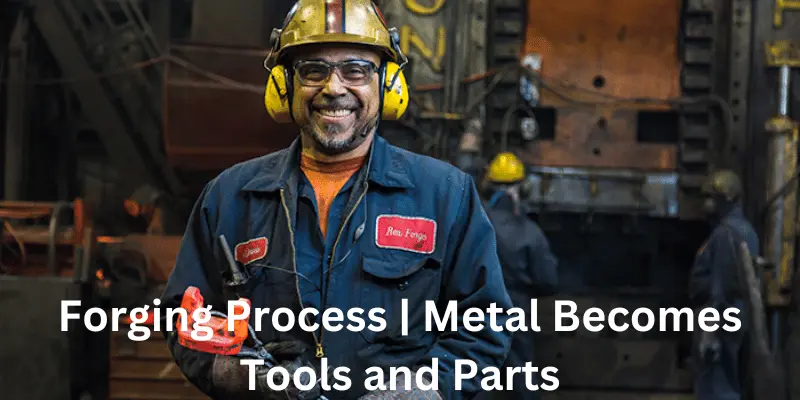Forging Process
Updated: 17 Oct 2024
569
Forging process is a special way to shape metal. Imagine taking a piece of clay and making it into a fun shape. Forging does the same with metal, making it stronger and ready for many uses.
In forging, metal is heated until it gets soft. Then, workers use hammers or machines to hit the metal and change its shape. This process helps create tools, car parts, and many other important things we use every day.

History of Forging
Forging is an ancient process that started over 4,000 years ago. It began in places like Egypt and Mesopotamia when people discovered how to shape metal by heating it. At first, they used simple tools like hammers made of stone or wood. Over time, blacksmiths emerged as skilled workers who created amazing things from metal. In ancient times, blacksmiths made weapons, tools, and jewelry.
They used fires to heat metal until it glowed. During the Middle Ages, forging became more important. Blacksmiths helped build castles, horseshoes, and tools for farmers. With the invention of machines in the 18th century, forging changed again. Factories began using big machines to forge metal faster and in larger amounts.
Today, forging is still used to create strong metal products, and it plays a vital role in making cars, airplanes, and many everyday items. Forging shows how humans have used creativity and skill to shape materials for thousands of years.
What is the Forging Process?
Forging is a method used to shape metal into different forms. It makes metal stronger and helps create many tools and parts we use every day.
- Heating the Forging Process Metal:
- Shaping the Forging Process Metal:
- Cooling the Forging Process Metal:
Types of Forging Processes
Forging has different types. Each type shapes metal in unique ways. Here are some common types of forging:
- Open-Die Forging:
- Metal placed between two large flat dies.
- Hammers hit the metal to shape it.
- Used for large parts like beams or axles.
- Closed-Die Forging:
- Metal placed in a die with a specific shape.
- The die has a top and bottom that close around the metal.
- Gives precise shapes and details, like tools and small parts.
- Upset Forging:
- Metal is compressed from the ends to make it thicker.
- Used to create parts like bolts or nuts.
- Helps make stronger connections.
- Roll Forging:
- Metal passed through rollers to change shape.
- Creates long pieces like bars or rods.
- Efficient for making many parts quickly.
- Precision Forging:
- Uses advanced methods to create very accurate shapes.
- Reduces waste and makes parts fit better.
- Used in aerospace and automotive industries.
- Swaging:
- Metal is shaped by being struck with a hammer or pressed.
- Changes diameter or length without cutting.
- Used for making tubes, wires, or other small parts.
Different Conditions Forgings Are Supplied In
When we make forged metal parts, they can be in different conditions. Here are the main conditions:

- Hot Forged:
- This means metal is shaped while it is still hot.
- Hot forging makes metal easy to work with.
- It helps create strong shapes.
- Cold Forged:
- Cold forging happens when metal is shaped at room temperature.
- This process makes the metal stronger without heat.
- Cold forging is great for small parts, like screws and bolts.
- Annealed:
- Annealing is a process where heated metal cools down slowly.
- This makes metal softer and easier to shape.
- Annealed forgings are good for further processing.
- Normalized:
- Normalization involves heating metal and letting it cool in air.
- This makes the metal strong and tough.
- Normalized forgings are often used in heavy machines.
- Quenched and Tempered:
- This means the metal is heated and then quickly cooled in water or oil.
- Quenching makes the metal hard.
- Tempering is heating again at a lower temperature, making it less brittle.
- These are used for tools and parts needing high strength.
- Surface Treated:
- Surface treatment adds a layer to protect the metal.
- This helps prevent rust and wear.
- It makes the forged parts last longer.
Standard Forging Equipment
Forging equipment helps shape metal. Different tools and machines are used to make the forging process easier and more efficient. Let’s learn about some of the important equipment used in forging!
- Furnace:
- A furnace is a big oven that heats metal until it gets hot and soft.
- It can reach very high temperatures so the metal can be easily shaped.
- Hammer:
- Hammers are heavy tools that strike the hot metal.
- Workers use hammers to shape the metal into different forms. There are different types of hammers, including:
- Hand Hammers: Used by blacksmiths for smaller jobs.
- Power Hammers: Machines that can hit metal many times quickly.
- Anvil:
- An anvil is a solid block of metal that sits on a sturdy base.
- When workers hit the hot metal with hammers, they place it on the anvil. The anvil helps shape the metal evenly.
- Press:
- A press is a machine that pushes or pulls metal into shape.
- It uses a lot of force to make sure the metal is formed accurately and evenly.
- Tongs:
- Tongs are special tools used to hold hot metal.
- They keep workers safe from burning their hands.
- Die:
- A die is a mold used to create specific shapes in metal.
- The metal is pressed into the die to form things like gears or parts for machines.
- Quenching Tank:
- After shaping, metal is often cooled quickly in a tank of water or oil.
- This process is called quenching. It helps make the metal hard and strong.
Why is Forging Equipment Important?
- Safety: Equipment helps keep workers safe while shaping hot metal.
- Efficiency: Machines and tools make the forging process faster and easier.
- Quality: Good equipment ensures that the final metal products are strong and reliable.
How Does Forging Strengthen Metal?
When metal is forged, it becomes stronger because of how it is shaped. First, the metal is heated, making it soft and easy to mold. Then, when workers hit the hot metal with hammers or presses, they push the metal’s tiny particles closer together. This helps the metal become denser and less likely to break. After shaping, when the metal cools down, its new structure holds together tightly, making it very strong.
So, forging helps metal resist stress and pressure, which means it can last longer and be used for heavy-duty tasks, like making tools and parts for machines!
What Products Require Forged Metal?
Forged metal is used to make many important things we use every day. Here are some products that need forged metal:
- Tools:
- Many tools, like hammers, wrenches, and pliers, are made from forged metal. These tools are strong and help us fix things around the house.
- Car Parts:
- Cars have many parts made from forged metal. This includes parts like the crankshaft, gears, and suspension components. Forged metal makes these parts tough and safe.
- Bicycle Frames:
- The frame of a bicycle is often made from forged metal. This helps make the bike lightweight and strong, so it can hold the rider safely.
- Machinery:
- Big machines, like those used in factories, have parts made from forged metal. These parts can handle heavy work without breaking.
- Sporting Equipment:
- Some sporting equipment, like golf clubs and certain types of bikes, are made from forged metal. This helps improve performance and make the equipment last longer.
- Construction Materials:
- Forged metal is used in construction for things like beams, bolts, and connectors. These materials help build strong buildings and bridges.
- Knives and Cutlery:
- High-quality knives and kitchen tools are often forged. This makes them sharper and more durable.
- Jewelry:
- Some beautiful pieces of jewelry are made using forged metal techniques. This gives them unique shapes and strength.
Uses of the Forging Process
Forging is used to create many important things in our daily lives. Here are some uses of the forging process:
- Aerospace:
- In airplanes, parts like landing gear and engine components are forged. These parts need to be very strong to keep us safe while flying.
- Medical Equipment:
- Some medical tools and devices, like surgical instruments, are forged. This ensures they are strong and reliable when used in hospitals.
- Art and Decoration:
- Forging can also create beautiful art pieces, gates, and railings. Blacksmiths make unique designs that add beauty to our surroundings.
Why Use Forging?
- Strength: Forged items are very strong and can last a long time.
- Precision: Forging allows for precise shapes and sizes, which is important for fitting parts together.
- Efficiency: Forging is a quick way to produce many items at once.
Advantages and Disadvantages of the Forging Process
Pros of Forging
| Benefits of Forging Process |
|---|
|
Cons of Forging
| Drawback of Forging Process |
|---|
|
Conclusion
Forging is a special way to shape metal. By heating, shaping, and cooling, we can create strong and durable items. Forging helps make important tools and parts that we use every day, like bicycle frames and car parts. It’s a process that has been around for a long period and still plays a big role in our lives today. Understanding forging shows us how people can turn simple pieces of metal into amazing things!
Please Write Your Comments